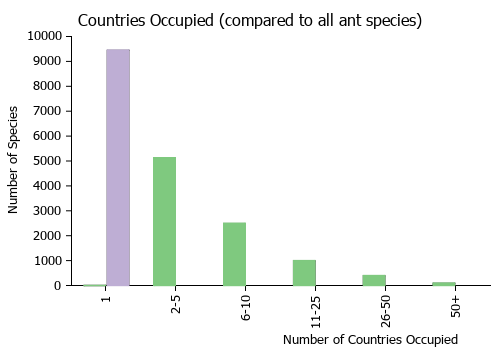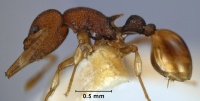Epopostruma curiosa
| Epopostruma curiosa | |
|---|---|

| |
| Scientific classification | |
| Kingdom: | Animalia |
| Phylum: | Arthropoda |
| Class: | Insecta |
| Order: | Hymenoptera |
| Family: | Formicidae |
| Subfamily: | Myrmicinae |
| Tribe: | Attini |
| Genus: | Epopostruma |
| Species: | E. curiosa |
| Binomial name | |
| Epopostruma curiosa Shattuck, 2000 | |
This species is one of the most morphologically distinctive in the genus. Unfortunately nothing is known of its biology.
Identification
This species stands out from all others in the genus. It is unique in lacking pronotal spines and erect hairs on the upper surfaces of the mesosoma, petiole, postpetiole and gaster, the elongate, cone-shaped eyes and the enlarged petiole.
Keys including this Species
Distribution
Latitudinal Distribution Pattern
Latitudinal Range: -27.21666667° to -30.13333333°.
| North Temperate |
North Subtropical |
Tropical | South Subtropical |
South Temperate |
- Source: AntMaps
Distribution based on Regional Taxon Lists
Australasian Region: Australia (type locality).
Distribution based on AntMaps
Distribution based on AntWeb specimens
Check data from AntWeb
Countries Occupied
| Number of countries occupied by this species based on AntWiki Regional Taxon Lists. In general, fewer countries occupied indicates a narrower range, while more countries indicates a more widespread species. |

|
Estimated Abundance
| Relative abundance based on number of AntMaps records per species (this species within the purple bar). Fewer records (to the left) indicates a less abundant/encountered species while more records (to the right) indicates more abundant/encountered species. |

|
Biology
Castes
Nomenclature
The following information is derived from Barry Bolton's Online Catalogue of the Ants of the World.
- curiosa. Epopostruma curiosa Shattuck, in Bolton, 2000: 59, figs. 61, 73, 88 (w.) AUSTRALIA.
Type Material
- Holotype, worker, Killarney Gap, Narrabri, New South Wales, Australia, Room,P.M., ANIC32-003998, Australian National Insect Collection.
Description
In full face view the lateral margin of the head between the eye and the posterior corner a broad convexity. Eyes projecting laterally away from the head in a blunt cone. Pronotal spines absent. Posterior section of metanotum and dorsal surface of the propodeum forming a continuous surface. Posterior face of propodeum between bases of spines and propodeal lobes with broad flanges. Petiole greatly enlarged, lacking spines, postpetiole unusually small. Anterior face of postpetiole short and merging into the dorsal face; sides of postpetiole expanded laterally in the form of thin, solid wings, their outer margins convex; posterolateral margin of postpetiole (immediately anterior of gaster) flat. Dorsum of petiole, postpetiole and gaster lacking erect hairs. First gastral tergite smooth; gaster immediately behind attachment with gaster with short, longitudinal rugae. Body colour yellow-red, propodeal spines and flanges and petiole and postpetiole darker; gaster yellow with a dark central band.
Measurements
Holotype worker. TL 3.4mm, HL 0.74mm, HW 0.65mm, CI 88, MandL 0.43mm, MandI 58, SL 0.44mm, SI 68, PronW 0.44mm, ML 0.86mm.
References
- Shattuck, S. O. 2000. Genus Colobostruma. Genus Mesostruma. Genus Epopostruma. Pp. 31-67 in: Bolton, B. The ant tribe Dacetini. Mem. Am. Entomol. Inst. 65: 1-1028 (page 57, worker described)


